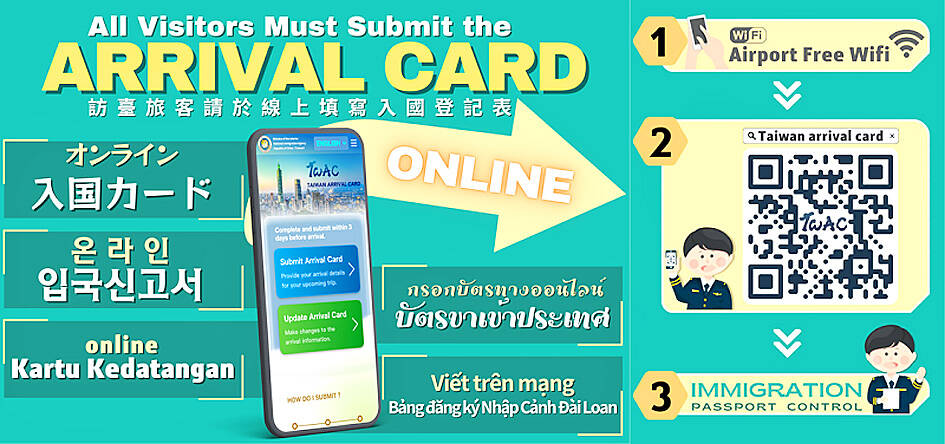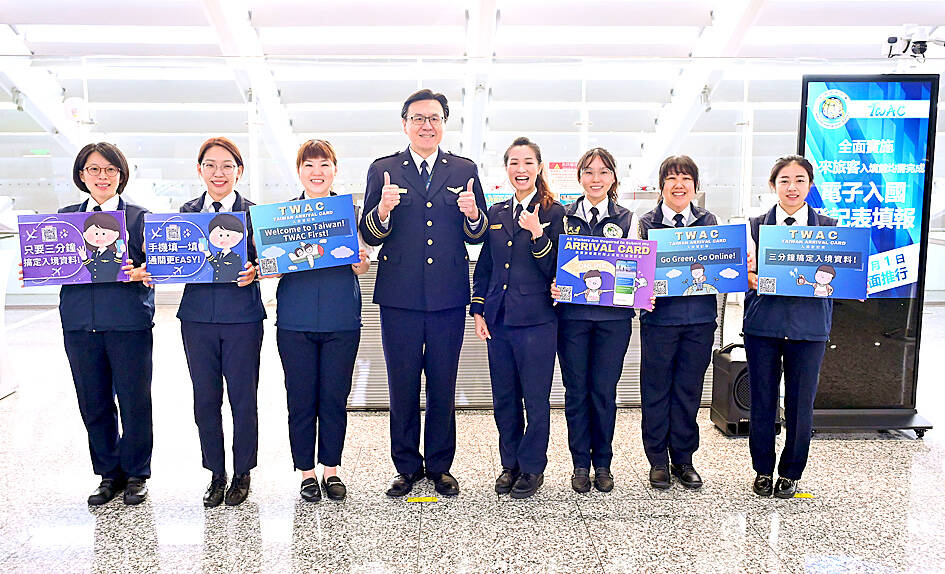Starting on Oct. 1, foreign nationals visiting Taiwan have to fill out an online arrival card three days before entering the nation’s borders, as paper forms are being phased out, the National Immigration Agency announced yesterday.
The policy would expedite foreigners’ passage through immigration while reducing waste, the agency said.
Introduced on May 5, the online arrival card, whose format aligns with international trends, has been well-received, it said.

Photo courtesy of the National Immigration Agency
The arrival card is available in Chinese, English, Japanese, Korean, Thai, Vietnamese and Indonesian, it said.
Travelers can opt to upload a basic information page from their passport, which the system would reference, reducing the time needed to complete the form, it added.
One person can fill out forms for up to 16 people, including tour groups or families visiting Taiwan, which further reduces the customs clearance process, the agency said.

Photo: Chu Pei-hsiung, Taipei Times
Immigration officials can access information on the online arrival card once the traveler is standing at the gate awaiting clearance to expedite the process, it said.
Airline companies are to receive QR codes that are to be displayed at airports and harbors, allowing travelers who have not completed their form in advance to scan them, ideally before their passport is checked at immigration, to facilitate the clearance process, it added.
In other developments, Democratic Progressive Party Legislator Hsu Chih-chieh (許智傑) yesterday said that passenger traffic at Kaohsiung International Airport has recovered to 89 percent of the volume before the COVID-19 pandemic.
The figure is higher than that of Taiwan Taoyuan International Airport, which has only reported a 76 percent recovery rate, he said.
There are 33 routes flying from Kaohsiung International Airport this summer, with 362 flights flying out of the airport per week, Hsu said.
Citing Civil Aviation Administration data, he said that Kaohsiung saw 1.8 million travelers passing through the airport from January to April this year, which is about 92 percent of pre-pandemic traveler volume.
With the onset of summer, the airport could return to about 98 percent of pre-pandemic traveler volume, he added.
Commenting on flights to Europe, the US and Australia, Hsu said he had visited United Airlines, which said that it was assessing the possibility of flying from Kaohsiung to San Francisco with a stopover in Tokyo, starting on July 11.
Most trans-Pacific flights from the US to Taiwan usually arrive before 9pm and there should not be a curfew issue, he said.
With the exception of Taiwan Taoyuan International Airport, every other airport in Taiwan has a curfew to prevent noise affecting nearby residents.
Hsu said he is working with airlines to develop new routes to Vietnam, Japan and Malaysia, which would link southern Taiwan to the rest of the world.

CROSS-STRAIT COLLABORATION: The new KMT chairwoman expressed interest in meeting the Chinese president from the start, but she’ll have to pay to get in Beijing allegedly agreed to let Chinese Nationalist Party (KMT) Chairwoman Cheng Li-wun (鄭麗文) meet with Chinese President Xi Jinping (習近平) around the Lunar New Year holiday next year on three conditions, including that the KMT block Taiwan’s arms purchases, a source said yesterday. Cheng has expressed interest in meeting Xi since she won the KMT’s chairmanship election in October. A source, speaking on condition of anonymity, said a consensus on a meeting was allegedly reached after two KMT vice chairmen visited China’s Taiwan Affairs Office Director Song Tao (宋濤) in China last month. Beijing allegedly gave the KMT three conditions it had to

‘BALANCE OF POWER’: Hegseth said that the US did not want to ‘strangle’ China, but to ensure that none of Washington’s allies would be vulnerable to military aggression Washington has no intention of changing the “status quo” in the Taiwan Strait, US Secretary of Defense Pete Hegseth said on Saturday, adding that one of the US military’s main priorities is to deter China “through strength, not through confrontation.” Speaking at the annual Reagan National Defense Forum in Simi Valley, California, Hegseth outlined the US Department of Defense’s priorities under US President Donald Trump. “First, defending the US homeland and our hemisphere. Second, deterring China through strength, not confrontation. Third, increased burden sharing for us, allies and partners. And fourth, supercharging the US defense industrial base,” he said. US-China relations under

The Chien Feng IV (勁蜂, Mighty Hornet) loitering munition is on track to enter flight tests next month in connection with potential adoption by Taiwanese and US armed forces, a government source said yesterday. The kamikaze drone, which boasts a range of 1,000km, debuted at the Taipei Aerospace and Defense Technology Exhibition in September, the official said on condition of anonymity. The Chungshan Institute of Science and Technology and US-based Kratos Defense jointly developed the platform by leveraging the engine and airframe of the latter’s MQM-178 Firejet target drone, they said. The uncrewed aerial vehicle is designed to utilize an artificial intelligence computer

The Chinese Nationalist Party (KMT) caucus yesterday decided to shelve proposed legislation that would give elected officials full control over their stipends, saying it would wait for a consensus to be reached before acting. KMT Legislator Chen Yu-jen (陳玉珍) last week proposed amendments to the Organic Act of the Legislative Yuan (立法院組織法) and the Regulations on Allowances for Elected Representatives and Subsidies for Village Chiefs (地方民意代表費用支給及村里長事務補助費補助條例), which would give legislators and councilors the freedom to use their allowances without providing invoices for reimbursement. The proposal immediately drew criticism, amid reports that several legislators face possible charges of embezzling fees intended to pay